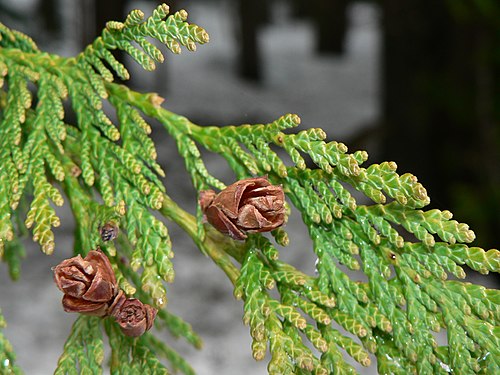Thuja plicata
| Habit | tree
| |
|---|---|---|
| Height: | ⇕ | 70 ft"ft" can not be assigned to a declared number type with value 70. to 120 ft"ft" can not be assigned to a declared number type with value 120. |
| Width: | ⇔ | 15 ft"ft" can not be assigned to a declared number type with value 15. |
| Lifespan: | ⌛ | perennial |
| Exposure: | ☼ | sun |
|---|---|---|
| USDA Zones: | 5 to 10 |
|
Thuja > |
plicata > |
Western Red Cedar (Thuja plicata) is a species of Thuja, an evergreen coniferous tree in the cypress family Cupressaceae. In the American horticultural trade, it is also known as the Giant Arborvitae, Arborvitae being another name for its genus.
The Western Red Cedar is not actually a cedar (Cedrus), but belongs in the Cupressaceae family, along with cypresses. It is known by many names: Pacific red cedar, British Columbia cedar, canoe cedar, giant cedar, and red cedar.[1]
The Western Red Cedar is a large tree, ranging between 40 to 150 feet (12 to 45 meters) tall and up to 22 feet (7 meters) in trunk diameter. Trees growing in the open will exhibit a crown that reaches the ground, whereas trees densely spaced together will only exhibit a crown at the top, where light can reach the leaves.[2] Some individuals can live nearly a thousand years, if not more.
The foliage forms flat sprays with scale-like leaves in opposite pairs, with successive pairs at 90° to each other. The foliage sprays are green above, and green marked white with stomatal bands below. The cones are slender, 15–20 mm long and 4–5 mm broad, with 8-12 thin, overlapping scales.
Read about Thuja plicata in the Standard Cyclopedia of Horticulture
|
|---|
|
Thuja plicata, Don (T. gigantea, Nutt. T. Menziesii, Douglas. T. Lobbii, Hort.). Tall tree, attaining 200 ft., with short horizontal branches often pendulous at the ends, forming a narrow pyramid: trunk with a much-buttressed base and clothed with cinnamon-red bark: branchlets slender, regularly and closely set: lvs. bright green and glossy above, dark green beneath and with whitish triangular spots: lvs. of vigorous shoots widely spaced, ending in long points parallel to axis, of the lateral branchlets acute and scarcely glandular: cones cylindric-ovoid, little over 1/2 in. long; scales 8-10, elliptic-oblong, usually the 3 middle pairs fertile; seeds winged, notched at the apex. Alaska to N. Calif. and Mont. Var. atrovirens, Sudw. (T. gigantea atrovirens, Beissn.). Foliage dark green. Var. fastigiata, Schneid. (T. gigantea fastigiata, Beissn. T. gigantea pyramidalis, Bean). Columnar form. Var. gracilis, Rehd. (T. gigantea var. gracilis, Beissn.). Smaller tree, with more slender branches and smaller foliage of paler green. Var. pendula, Schneid. (T. gigantea pendula, Beissn.). Form with slender pendulous branches. CH
|
Cultivation
- Do you have cultivation info on this plant? Edit this section!
Propagation
- Do you have propagation info on this plant? Edit this section!
Pests and diseases
- Do you have pest and disease info on this plant? Edit this section!
Species
Gallery
If you have a photo of this plant, please upload it! Plus, there may be other photos available for you to add.
References
- Standard Cyclopedia of Horticulture, by L. H. Bailey, MacMillan Co., 1963
External links
- w:Thuja plicata. Some of the material on this page may be from Wikipedia, under the Creative Commons license.
- Thuja plicata QR Code (Size 50, 100, 200, 500)







